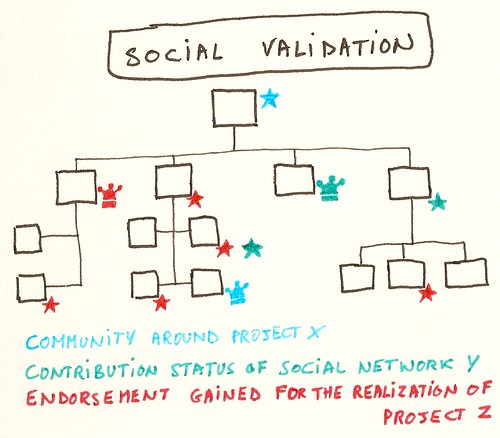It’s time to pimp your employee database, because with the term Social Validation we are getting very close to a way to develop and sustain a Social Architecture.
Collaboration is the new literacy, but it requires managers to replace systems of control with platforms of trust. This is exactly the possibility that is offered by social media such as Facebook, LinkedIn and Twitter. Social media are rapidly maturing from a ‘danger to productivity’ towards ‘tools for productivity’. As a consequence, it is the extent to which information is shared and tagged with meaning that determines the status of those who share it and interact around it.
Looking for Communities
To most managers it is clear that control is no longer the shortest path to productivity. In a digital economy that thrives on collaboration and crowd-sourcing, it is better to focus on co-creation with the community that is built around your initiative.
It’s tempting to think that you need to create a community for the thing you want to kick-off. Here’s the secret: you don’t. That community already exists. Communities typically gather around business processes and solutions that are transversal. A hierarchy with silos can’t cater for that. So instead of creating the community you should be ‘listening for’ the community. Chances are that it is right there below your feet and that you’ve been standing on it all the time. Search for the business process owners or other people that have been fighting for a good cause without a hierarchy to back them up.
The first step is to discover the places in your organization where communities have formed around an initiative, an issue or problem. Then you offer them a platform, for example the administrative support of a company-wide program. Another example is a communication platform or a forum to gain recognition within your organization.
Social Validation
Once you have created a social architecture you need to maintain and develop it even further – NOT by the classic control-based rewards, benefits and allowances but by something that works far better. It is called social validation. This is a term that I have picked up from Jef Staes last month as we were discussing the impact of the digital economy.
Social validation is the way to value ambassadors and heroes who work hard for a goal. Social validation is done from several directions at the same time: employees, supervisors, colleagues and even competitors. Most important, it happens in real time and according to the dynamics of the new literacy of collaboration.

Until now there was no way to record appreciation in a formal way; but recently the Facebook generation has made us familiar with the “I like” button. Platforms like Yammer and Rypple are well equipped to support social validation with thanks, objectives, medals and formal feedback. But first you will need to provide some structure. This happens in several steps:
- start looking for communities, ambassadors and heroes;
- Among the ambassadors, designate a specific roles in function of the program;
- Honor these ambassadors by asking for their input;
- Expose the ambassadors to their engagement;
- Go back to step 3 and continuously perform the loop 3-4-5.
Pimp your Employee Data
From my experience it is very easy to build a system that visualizes the social architecture of your organization. I have been doing this by means of databases for every major ERP roll-out I have been involved in the past 10 years. In short, here are some essential things to remember:
- The personnel list of the organization is the backbone of such a system
- Build a list of contexts and roles that people can have in your social architecture and attach employees to the right roles
- The fun part: as you go people start learning and performing on these roles and thus their status of these roles starts to change from beginner to expert and so on
- Finally: link it back to what matters to the hierarchy: security and authorizations management and the learning management system of the company.
- Surprise, surprise… thanks to the rise of social media there is a fifth step! With a little technical support you can chart by any membership of any social network in the same way as you chart a role within a project or a workgroup. These can be both internal and external networks. Next, you can display the “membership” status: is this a light, medium or advanced member?
It gets even more interesting once you integrate the social feedback:
- did this person receive a lot of ‘likes’ on this particular project?
- is this person a good contributor of that particular community?
- did this person gain enough experience points or endorsements in that community?



Pingback: Don’t Fence Me In (Book Review) | Reply-MC()
Pingback: Claiming Our Performance Back | Reply-MC()